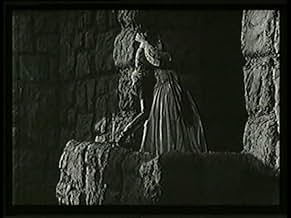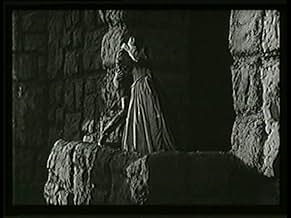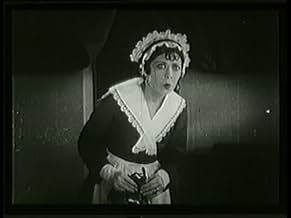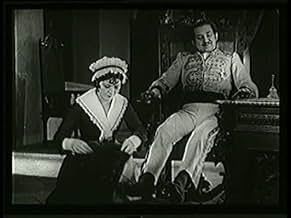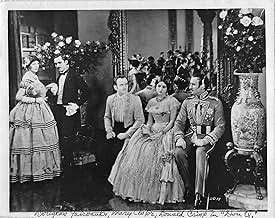IMDb-BEWERTUNG
6,9/10
600
IHRE BEWERTUNG
Füge eine Handlung in deiner Sprache hinzuDon Cesar, son of Zorro, is framed for murder while visiting Spain, and becomes the whip-wielding outlaw Don Q.Don Cesar, son of Zorro, is framed for murder while visiting Spain, and becomes the whip-wielding outlaw Don Q.Don Cesar, son of Zorro, is framed for murder while visiting Spain, and becomes the whip-wielding outlaw Don Q.
- Auszeichnungen
- 3 wins total
Stella De Lanti
- Queen Isabella
- (as Stella DeLanti)
Lottie Pickford
- Lola
- (as Lottie Pickford Forrest)
George Blankman
- Undetermined Secondary Role
- (Nicht genannt)
Charles Byer
- Undetermined Secondary Role
- (Nicht genannt)
Robert McKim
- Capitán Juan Ramon
- (Archivfilmmaterial)
- (Nicht genannt)
Empfohlene Bewertungen
Film sequels were a novelty in 1925, when DON Q, SON OF ZORRO marked a big profit for United Artists. Then and now, it is considered to be a better film than the original, THE MARK OF ZORRO (1920), which made star and producer Douglas Fairbanks the personification of the Swashbuckler five years earlier.
Since his screen debut in 1915, Fairbanks had always been cast in contemporary comedies as a fun-loving, never-say-die, go-getter who gets the girl and catches the bad guys all the while exhibiting his athletic prowess and bravado. He was a major film actor, but his popularity was beginning to wane due to the monotony of his roles and vehicles.
The formation of United Artists Corporation in 1919 gave founders Fairbanks, Mary Pickford, Charlie Chaplin and D.W. Griffith control over their own projects. Fairbanks chose this opportunity to risk reinventing his image by starring in this film adaptation of The Curse of Capistrano. The serialized novel written by Johnston McCulley had been published that year in a popular pulp magazine. It introduced the character of Zorro to the world. The magic of the movie assured Zorro's place among fictional super-heroes. The character lived on in several more film versions as well as books, comics, cartoons, Halloween costumes, toys, and in the popular 1950's television series starring Guy Williams.
In THE MARK OF ZORRO, set in early 19th century California, Fairbanks came up with an ingenious concept showcasing his likable contemporary stock character into an action/adventure period costume picture. He plays Don Diego Vega, the milksop son of an affluent rancher who, like the Scarlet Pimpernel, dons a disguise to defend the impoverished townsfolk from the tyrants in power. His alter ego Zorro's, (Spanish for fox) trademarks are the black cape and cowl mask he wears and the master swordsmanship he displays. He is known to brand his victims with a "Z" made with three fast strokes of his blade. At the end of the film, after Zorro's greatest triumph, his identity is revealed. He throws his sword into the air. It lodges into a high spot on the wall, as Zorro shouts, "Till I need you again!" Though it was probably not Fairbanks' intention at the time, this line was a prime set-up for a sequel if there ever was one.
After the tremendous financial and critical success of ZORRO, Fairbanks continued to give the public what it wanted the charismatic Fairbanks persona in lavish period epics. THE THREE MUSKETEERS, ROBIN HOOD and THE THIEF OF BAGDAD were all released in the years between the two Zorro epics.
As one can easily discern by the title of this follow-up, Doug is back as Diego's son - namely Don Cesar, aka "Don Q." The screenplay is based on the novel "Don Q's Love Story" by Hesketh Prichard and Kate Prichard which had no relationship to Zorro at all. But by making Don Q the offspring of the famous hero, it cashed in on the audience's familiarity with the original and made it possible for Doug to play a dual role as both father and son.
In the family tradition, Don Cesar is sent to Spain to continue his education and learn the traditions of his ancestors. His high-spirited ways and showmanship with a bullwhip make him a favorite of the Queen's cousin, Archduke Paul of Austria (Warner Oland). Cesar also makes an enemy of surly Don Sebastian (Donald Crisp), a member of the Queen's guard, and both men fall for the beautiful Dolores de Muro (Mary Astor). After Cesar is framed for murder, he fakes suicide and goes underground until he can prove the guilt of the real killer. Meanwhile, in California, Don Diego receives word of his son's predicament. He retrieves his sword from where it had stuck thirty years before, digs out his mask and cape and travels to Spain to help rescue his son. Father and son take on 15 soldiers in a sword fight during the film's exuberant finale.
Audiences and critics alike loved DON Q even more than the original. Film-making technique and technology had improved rapidly since 1920. The sequel had a stronger plot, higher production values and better pacing. What's more, Fairbanks has fine-tuned his swashbuckler persona to perfection. He was never was he more cocksure, flamboyant and amusing than he appears here. Though already 41 years old, he easily got away with playing a much younger character in no small part due to his physical fitness. He is shown to great advantage, engaging in sword-play, jumping on a horse or his specialty in this film - cracking a whip. Well known for performing his own stunts, Doug reportedly spent six weeks learning fancy whipmanship. He uses it to light a cigarette, extinguish a candle, slice paper, lasso a bull and swing onto a balcony. He also shows himself to be a dandy on the dance floor in a parody of a Valentino tango.
Donald Crisp, best known for his chilling performance as Lillian Gish's cruel father in BROKEN BLOSSOMS, does double duty in DON Q as both co-star and director. He plays Fairbanks' dastardly nemesis Don Sebastian while directing one of his best films. Crisp directed more than 70 films, including the Buster Keaton classic,THE NAVIGATOR. He got his start in the movies in 1908 with the Biograph Company and appeared on screen for the last time 55 years later as Grandpa Spencer in the 1963 film SPENCER'S MOUNTAIN that starred Henry Fonda. Crisp died in 1974.
The New York Times thought so highly of DON Q, SON OF ZORRO, that they named it one the 10 best films of 1925.
While enjoyable on TV or home video, the movie is twice the fun when watched with live accompaniment and an audience as I was fortunate to experience at Cinevent 2006.
Since his screen debut in 1915, Fairbanks had always been cast in contemporary comedies as a fun-loving, never-say-die, go-getter who gets the girl and catches the bad guys all the while exhibiting his athletic prowess and bravado. He was a major film actor, but his popularity was beginning to wane due to the monotony of his roles and vehicles.
The formation of United Artists Corporation in 1919 gave founders Fairbanks, Mary Pickford, Charlie Chaplin and D.W. Griffith control over their own projects. Fairbanks chose this opportunity to risk reinventing his image by starring in this film adaptation of The Curse of Capistrano. The serialized novel written by Johnston McCulley had been published that year in a popular pulp magazine. It introduced the character of Zorro to the world. The magic of the movie assured Zorro's place among fictional super-heroes. The character lived on in several more film versions as well as books, comics, cartoons, Halloween costumes, toys, and in the popular 1950's television series starring Guy Williams.
In THE MARK OF ZORRO, set in early 19th century California, Fairbanks came up with an ingenious concept showcasing his likable contemporary stock character into an action/adventure period costume picture. He plays Don Diego Vega, the milksop son of an affluent rancher who, like the Scarlet Pimpernel, dons a disguise to defend the impoverished townsfolk from the tyrants in power. His alter ego Zorro's, (Spanish for fox) trademarks are the black cape and cowl mask he wears and the master swordsmanship he displays. He is known to brand his victims with a "Z" made with three fast strokes of his blade. At the end of the film, after Zorro's greatest triumph, his identity is revealed. He throws his sword into the air. It lodges into a high spot on the wall, as Zorro shouts, "Till I need you again!" Though it was probably not Fairbanks' intention at the time, this line was a prime set-up for a sequel if there ever was one.
After the tremendous financial and critical success of ZORRO, Fairbanks continued to give the public what it wanted the charismatic Fairbanks persona in lavish period epics. THE THREE MUSKETEERS, ROBIN HOOD and THE THIEF OF BAGDAD were all released in the years between the two Zorro epics.
As one can easily discern by the title of this follow-up, Doug is back as Diego's son - namely Don Cesar, aka "Don Q." The screenplay is based on the novel "Don Q's Love Story" by Hesketh Prichard and Kate Prichard which had no relationship to Zorro at all. But by making Don Q the offspring of the famous hero, it cashed in on the audience's familiarity with the original and made it possible for Doug to play a dual role as both father and son.
In the family tradition, Don Cesar is sent to Spain to continue his education and learn the traditions of his ancestors. His high-spirited ways and showmanship with a bullwhip make him a favorite of the Queen's cousin, Archduke Paul of Austria (Warner Oland). Cesar also makes an enemy of surly Don Sebastian (Donald Crisp), a member of the Queen's guard, and both men fall for the beautiful Dolores de Muro (Mary Astor). After Cesar is framed for murder, he fakes suicide and goes underground until he can prove the guilt of the real killer. Meanwhile, in California, Don Diego receives word of his son's predicament. He retrieves his sword from where it had stuck thirty years before, digs out his mask and cape and travels to Spain to help rescue his son. Father and son take on 15 soldiers in a sword fight during the film's exuberant finale.
Audiences and critics alike loved DON Q even more than the original. Film-making technique and technology had improved rapidly since 1920. The sequel had a stronger plot, higher production values and better pacing. What's more, Fairbanks has fine-tuned his swashbuckler persona to perfection. He was never was he more cocksure, flamboyant and amusing than he appears here. Though already 41 years old, he easily got away with playing a much younger character in no small part due to his physical fitness. He is shown to great advantage, engaging in sword-play, jumping on a horse or his specialty in this film - cracking a whip. Well known for performing his own stunts, Doug reportedly spent six weeks learning fancy whipmanship. He uses it to light a cigarette, extinguish a candle, slice paper, lasso a bull and swing onto a balcony. He also shows himself to be a dandy on the dance floor in a parody of a Valentino tango.
Donald Crisp, best known for his chilling performance as Lillian Gish's cruel father in BROKEN BLOSSOMS, does double duty in DON Q as both co-star and director. He plays Fairbanks' dastardly nemesis Don Sebastian while directing one of his best films. Crisp directed more than 70 films, including the Buster Keaton classic,THE NAVIGATOR. He got his start in the movies in 1908 with the Biograph Company and appeared on screen for the last time 55 years later as Grandpa Spencer in the 1963 film SPENCER'S MOUNTAIN that starred Henry Fonda. Crisp died in 1974.
The New York Times thought so highly of DON Q, SON OF ZORRO, that they named it one the 10 best films of 1925.
While enjoyable on TV or home video, the movie is twice the fun when watched with live accompaniment and an audience as I was fortunate to experience at Cinevent 2006.
As an early Zorro movie, well, an early movie period, this was fairly good. I will admit that some of it was kind of dumb. The plot is that Zorro's son has been framed for a murder. This happens because someone forges the murder victim's signature saying he was the killer. How could anyone be fooled into thinking someone wrote down who their murderer was? Was this a thing back in the 1920's? The Zorro costume does in fact appear, but unfortunately it's only in the last ten minutes. With all that being said, this still is by no means a bad movie. The original Zorro movie was better.
While this was before color, I really was impressed by the tints of this movie. I guess they don't count as colors, but this really was a nice looking movie. The atmosphere is probably the strongest point, because this is a movie that's very nice to look at with great sets. It's so nice to see how well they hold up after nearly a hundred years! I like the idea of Zorro having a son, but this was interesting because he wasn't just taking on the persona of Zorro. He really was becoming a new character in his own right. Sequels shouldn't just repeat what the original did. It's great to point out the flaws in such an old movie. While not a classic, it's fine. ***
While this was before color, I really was impressed by the tints of this movie. I guess they don't count as colors, but this really was a nice looking movie. The atmosphere is probably the strongest point, because this is a movie that's very nice to look at with great sets. It's so nice to see how well they hold up after nearly a hundred years! I like the idea of Zorro having a son, but this was interesting because he wasn't just taking on the persona of Zorro. He really was becoming a new character in his own right. Sequels shouldn't just repeat what the original did. It's great to point out the flaws in such an old movie. While not a classic, it's fine. ***
Dashing Douglas Fairbanks (as Don Cesar de Vega) is the son of the legendary "Zorro", in this spectacular sequel to Mr. Fairbanks' own "The Mark of Zorro" (1920) *********. The younger Fairbanks has been sent to Spain, where he cracks his whip, and soaks up local color. There, he falls in love with pretty Mary Astor (as Dolores de Muro); watch out for the great introduction to Ms. Astor's character, as Fairbanks places wings on her silhouette. You know trouble is brewing when dastardly rival Donald Crisp (as Don Sebastian) is spurned by "belle of the Archduke's ball" Astor. In a fit of anger, Mr. Crisp assassinates Archduke Paul (as Warner Oland), and frames Fairbanks for the killing. Then, Fairbanks fakes his own suicide, and sets out to prove his innocence; eventually, he receives help from father "Zorro" (Fairbanks, in a dual role).
"Don Q, Son of Zorro" is a tremendous sequel, from Fairbanks and company, who wisely viewed follow-ups as a chance to equal, or improve upon, earlier hits. Not surprisingly, it lacks the spontaneity of the earlier film, and it is, perhaps, a little too long. However, the overall production is superior, and the storyline refreshingly unique; as "Don Q", and his story, are quite different than the original "Zorro". Crisp is very helpful, as both villain and director. And, Henry Sharp's photography is top notch.
The cast is terrific: alongside the aforementioned, you have Fairbanks regular Charles Stevens (as Robledo) in one of his more showy roles, otherwise humanitarian Jean Hersholt (as Don Fabrique) playing Crisp's blackmailing nemesis, famous sibling Lottie Pickford (as Lola), and Albert MacQuarrie (as Colonel Matsado) gets to ask Fairbanks: "Who the hell are you?"
"Don Q, Son of Zorro" is a tremendous sequel, from Fairbanks and company, who wisely viewed follow-ups as a chance to equal, or improve upon, earlier hits. Not surprisingly, it lacks the spontaneity of the earlier film, and it is, perhaps, a little too long. However, the overall production is superior, and the storyline refreshingly unique; as "Don Q", and his story, are quite different than the original "Zorro". Crisp is very helpful, as both villain and director. And, Henry Sharp's photography is top notch.
The cast is terrific: alongside the aforementioned, you have Fairbanks regular Charles Stevens (as Robledo) in one of his more showy roles, otherwise humanitarian Jean Hersholt (as Don Fabrique) playing Crisp's blackmailing nemesis, famous sibling Lottie Pickford (as Lola), and Albert MacQuarrie (as Colonel Matsado) gets to ask Fairbanks: "Who the hell are you?"
A sequel to one of Doug's best pictures that rousingly maintains the high standard of the original with much of the action played for laughs as Fairbanks effortlessly sees off the opposition while nonchalantly cracking a whip (even snapping a cigarette from Donald Crisp's mouth at one point!), mounting horses and performing other exhilarating feats of derring do.
Amidst all the macho brawling Lottie Pickford and Stella DeLanti (as the Queen) both make lively impressions in relatively brief roles; the latter early on, the former towards the end.
Amidst all the macho brawling Lottie Pickford and Stella DeLanti (as the Queen) both make lively impressions in relatively brief roles; the latter early on, the former towards the end.
The rollout for a Douglas Fairbanks movie during the summer was becoming a much-heralded annual ritual for movie fans. During the steamy days of 1925, the actor/producer released his sequel to the highly successful 1920 "The Mark of Zorro" in July 1925's "Don Q, Son of Zorro." Cinematic special effects created a double of Fairbanks as he appears in the film's later scenes as an aging Don Diego Vega (Zorro) while his son (Fairbanks) is seen in the same frame.
The actor/producer combined the Hesketh-Prichard 1909 novel 'Don Q.'s Love Story' with the Zorro character. Don Q, Cesar, possessed as his main defensive weapon a whip, but was also adept with the sword. And he never wears a mask to hide his identity. The story's location in Spain allows "Don Q" to have a totally different cast of characters, including Cesar's arch love rival, Sebastian (Donald Crisp), head of the Queen's Palace Guard. Crisp, released previously by Buster Keaton for his handling of portions of 1924's "The Navigator," capably directed "Don Q." Crisp was no slouch when it came to directing, sitting in the monogrammed chair for some 70 films before he went full-time acting.
It was an interesting time for lead actress Mary Astor, who played the love interest between Fairbanks and Crisp as Dolores. Just 19 years old and only a three-year veteran of the screen, Astor was one of a number of very young actresses whose parents lived off her salary. After discouraging actor John Barrymore from marrying their daughter while making 1924's "Beau Brummel," Otto and Helen Langhanke (Mary's birth name was Lucile Langhanke before Paramount Pictures changed it) controlled every aspect of her life.
Just after filming "Don Q," Mary was closely kept to her parents' hips when they bought a Moorish-style mansion known as 'Moorcrest,' in the hills above Hollywood just below the recently built famous sign. Charlie Chaplin previously rented the 1921 house, right across the Theosophical Society's utopian community called Krotona. The Langhankes became friends with Marie Hotchener, a Theosophist. When Marie heard the parents were taking Mary's entire $2,500 a week salary to pay the mortgage and other luxury items, she convinced the Langhandes to give their daughter $5 per week as an allowance.
Soon tiring from her father's physical and psychological abuse, Mary climbed out of her bedroom window and sought refuge in a Hollywood hotel. Mrs. Hotchener again became the intermediary between the family and negotiated her return to the parents by forcing them to deposit $500 in her bank account. Mary also supposedly obtained control of her finances, which never happened until she was 26, four years after she had married director Kenneth Hawks, the brother of film director Howard Hawks.
The actor/producer combined the Hesketh-Prichard 1909 novel 'Don Q.'s Love Story' with the Zorro character. Don Q, Cesar, possessed as his main defensive weapon a whip, but was also adept with the sword. And he never wears a mask to hide his identity. The story's location in Spain allows "Don Q" to have a totally different cast of characters, including Cesar's arch love rival, Sebastian (Donald Crisp), head of the Queen's Palace Guard. Crisp, released previously by Buster Keaton for his handling of portions of 1924's "The Navigator," capably directed "Don Q." Crisp was no slouch when it came to directing, sitting in the monogrammed chair for some 70 films before he went full-time acting.
It was an interesting time for lead actress Mary Astor, who played the love interest between Fairbanks and Crisp as Dolores. Just 19 years old and only a three-year veteran of the screen, Astor was one of a number of very young actresses whose parents lived off her salary. After discouraging actor John Barrymore from marrying their daughter while making 1924's "Beau Brummel," Otto and Helen Langhanke (Mary's birth name was Lucile Langhanke before Paramount Pictures changed it) controlled every aspect of her life.
Just after filming "Don Q," Mary was closely kept to her parents' hips when they bought a Moorish-style mansion known as 'Moorcrest,' in the hills above Hollywood just below the recently built famous sign. Charlie Chaplin previously rented the 1921 house, right across the Theosophical Society's utopian community called Krotona. The Langhankes became friends with Marie Hotchener, a Theosophist. When Marie heard the parents were taking Mary's entire $2,500 a week salary to pay the mortgage and other luxury items, she convinced the Langhandes to give their daughter $5 per week as an allowance.
Soon tiring from her father's physical and psychological abuse, Mary climbed out of her bedroom window and sought refuge in a Hollywood hotel. Mrs. Hotchener again became the intermediary between the family and negotiated her return to the parents by forcing them to deposit $500 in her bank account. Mary also supposedly obtained control of her finances, which never happened until she was 26, four years after she had married director Kenneth Hawks, the brother of film director Howard Hawks.
Wusstest du schon
- WissenswertesDanish composer Jacob Gade's internationally famous piece "Tango Jalousi" was composed for the Danish gala premiere of this film, which took place 14 September 1925 in Palads Teatret, Copenhagen.
- Zitate
Don Cesar de Vega: My father always said, "When you are in the right, fight; when you are in the wrong, acknowledge it."
- VerbindungenFeatured in Sprockets: Cliffhangers (1995)
Top-Auswahl
Melde dich zum Bewerten an und greife auf die Watchlist für personalisierte Empfehlungen zu.
Details
- Laufzeit1 Stunde 51 Minuten
- Sound-Mix
- Seitenverhältnis
- 1.33 : 1
Zu dieser Seite beitragen
Bearbeitung vorschlagen oder fehlenden Inhalt hinzufügen

Oberste Lücke
By what name was Der Mann mit der Peitsche (1925) officially released in Canada in English?
Antwort



